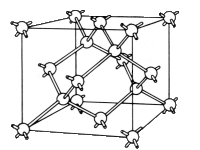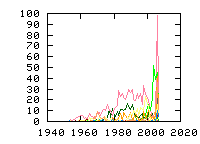« Previous
1
Next »
(7 hits, 1/1)
Showing
10, 25, 50, 100, 500, 1000, all papers per page.
Sort by:
last publication date,
older publication date,
last update date.
- 1. Phys. Rev. B 75, 193201 (2007) , “Compensating point defects in 4He+-irradiated InN”, F. Tuomisto, A. Pelli, K. M. Yu, W. Walukiewicz, and W. J. SchaffWe use positron annihilation spectroscopy to study 2 MeV 4He+-irradiated InN grown by molecular-beam epitaxy and GaN grown by metal-organic chemical-vapor deposition. In GaN, the Ga vacancies act as important compensating centers in the irradiated material, introduced at a... (Read more)
- 2. Appl. Phys. Lett. 89, 152123 (2006) , “Electrical characterization of defects introduced in n-type Ge during indium implantation”, F. D. Auret, P. J. Janse van Rensburg, M. Hayes, J. M. Nel, W. E. Meyer, S. Decoster, V. Matias, and A. VantommeThe authors have employed deep level transient spectroscopy to investigate the defects introduced in n-type Ge during 160 keV indium (In) ion implantation. Our results show that In implantation introduces three prominent electron traps with energy levels at... (Read more)
- 3. Appl. Phys. Lett. 88, 212102 (2006) , “Experimental determination of the local geometry around In and In–C complexes in Si”, F. d'Acapito, Y. Shimizu, S. Scalese, M. Italia, P. Alippi, S. GrassoThe electrical properties of dopants in Si are of primary importance for the realization of electronic devices. Indium represents a promising p-type dopant whose electrical properties are improved by codoping with C. From theoretical studies In and C are expected to pair in the Si matrix in... (Read more)
- 4. J. Appl. Phys. 100, 013518 (2006) , “Photoluminescence analysis on the indium doped Cd0.9Zn0.1Te crystal”, Qiang Li, Wanqi Jie, Li Fu, Ge Yang, Gangqiang Zha, Tao Wang, and Dongmei ZengPhotoluminescence spectra are used to characterize high resistivity of In-doped CdZnTe crystal. Shallow level donor-acceptor pair (DAPs) peak at 1.6014 eV is found due to shallow donor and acceptor compensation related defects, which forms the... (Read more)
- 5. J. Appl. Phys. 99, 113516 (2006) , “Investigation of the indium-boron interaction in silicon”, S. Scalese, S. Grasso, M. Italia, V. Privitera, J. S. Christensen, and B. G. SvenssonThe interaction between indium and boron coimplanted in silicon has been investigated. In particular, the effects of the coimplantation on the diffusion and the electrical activation have been studied in comparison with the single B or In implanted samples. It is shown that, by means of... (Read more)
- 6. Phys. Rev. Lett. 5, 309 (1960) , “Paramagnetic Resonance Absorption from Acceptors in Silicon”, G. Feher, J. C. Hensel, and E. A. GereIn the past,several attempts to observe the paramagnetic absorption from acceptors in silicon were unsuccessful.The reasons for this failure were pointed out by Kohn and are associated with the degeneracy of the valence band in silicon.We wish to report in this Letter the observation of the... (Read more)
- 7. Solid State Physics 5, 258-319 (1957) , Academic Press, New York (Edited by F. Seitz, D. Turnbull) , “Shallow Impurity States in Silicon and Germanium”, W. KohnI. Introduction (p.258): II. Emprical Properties (p.261): 1. Energy Levels (p.261), a. Ionization Energies, b. Spectra of Excited States, 2. Spin Resonance (p.266), a. Electron Spin Resonance, b. Double Resonance, 3. Static Magnetic Susceptibility (p.271), III. Structure of Donor States (p.271): 4. Conduction Bands of Silicon and Germanium (p.271), a. Silicon, b. Germanium, 5. Effective Mass Theory of Donor States (p.274), a. Single Band Minimum at k=0, b. Several Conduction Band Minima, c. Matrix Elements for Radiative Transitions, 6. Numerical Results and Comparison with Experiments (p.285), a. Energy Levels, b. Wave Functions, 7. Corrections to the Effective Mass Formalism (p.289), a. General Considerations, b. Corrected Wave Functions, c. Comparison with Experiment, IV. Structure of Acceptor States (p.297): 8. Valence Bands of Silicon and Germanium (p.297), a. Silicon, b. Germanium, 9. Effective Mass Equations for Acceptor States (p.300), 10. Approximate Solutions and Comparison with Experiment (p.301) a. Germanium b. Silicon V.Effects of Strains and of Static Electric and Magnetic Fields (p.306): 11. Strains (p.306) a. Donor States, b. Acceptor States, 12. Stark Effect (p.311)
« Previous
1
Next »
(7 hits, 1/1)
Showing
10, 25, 50, 100, 500, 1000, all papers per page.
Sort by:
last publication date,
older publication date,
last update date.
All papers (3399)
Updated at 2010-07-20 16:50:39
Updated at 2010-07-20 16:50:39
(view as: tree
,
cloud
)
| 1329 | untagged |
Materials
(111 tags)
Others(101 tags)
Technique
(46 tags)
Details
(591 tags)
Bond(35 tags)
Defect(interstitial)(18 tags)
Defect(vacancy)(15 tags)
Defect-type(19 tags)
Element(65 tags)
Energy(8 tags)
Isotope(56 tags)
Label(303 tags)
Sample(17 tags)
Spin(8 tags)
Symmetry(15 tags)

